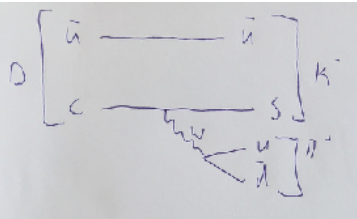Looking at the following Feynman diagram:
Using conservation of energy, we can see that in the rest frame of $D^0$, the energy of $K^-$ is higher than its rest energy. Meaning, it is in motion. I expected that since the particles in the hadron only exist as a set, that means that also the resulting $\bar{u}$ is in motion. But clearly by the same assumption, since $D^0$ is at rest in its own rest frame, also the initial $\bar{u}$ must be at rest. During the entire decay, $\bar{u}$ doesn't partake in any interaction, meaning that at the end, it should still be at rest, which is a contradiction.
I see two possible options to resolve this discrepancy: Either the different quarks that compose a Hadron can move at different speeds, or $\bar{u}$ somehow changes its speed without participating in any interaction. Neither of these seems possible.
Can someone please explain to me what I'm missing? Thanks.
Edit: After reading both anna's and nu's answers, I now understand, but I don't think I would have understood after reading either answer individually, so I'm not sure which answer I should select as correct. For now, I'm not selecting any answer, as I think ideally people visiting this question should read both.

